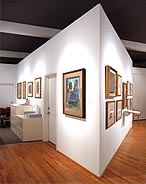 |
 |
From February 6th through
the end of May, 2004, ArtSpace/Virginia Miller Galleries
is holding a world-premiere exhibition titled “Gunther
Gerzso: Defining Mexican Abstractionism.” The
86 drawings and paintings are part of the collection
of Thomas Ireland, an actor who became a close friend
of Gerzso’s when he was a set and costume designer
at the Cleveland Playhouse from 1935 to 1941. Included
in the exhibition are several of Gerzso’s nonrepresentational,
abstract art.
Click here to
see the artwork. |
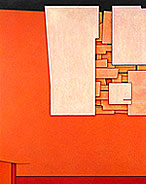 |
 |
These luminous works done
during the Mexican master’s mature period are suggestive
of the stone walls and architecture of the Mayans and
Aztecs, and their colors often subtly remind us of the
way Mexico’s blue skies contrast with the greens
of its jungles and the varied hues of its terracotta
walls. When viewed with Guther Gerzso’s early works,
the evolution of his art from costumed figures to the
illusions of stage set backgrounds to his eventual architectonic
abstract art becomes apparent.
Click here to see the
artwork. |
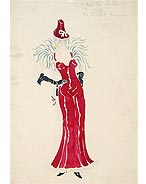 |
 |
After years of schooling
in languages and art history in Switzerland, Guther Gerzso
had just graduated from high school in Mexico City when
a visiting drama professor suggested to his mother that
the young artist, who had a adolescent dream of being
a set designer, should apply for an internship at the
Cleveland Playhouse, one of this nation’s most
important theatrical companies. After a year of doing
odd jobs, Gunther Gerzso became the theater’s Assistant
Technical Director. A month later, the theater’s
set designer retired, and Gerzso began designing the
company’s costumes and sets.
Click here to
see the artwork. |
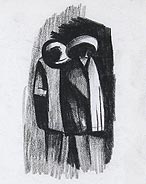 |
 |
| During his five years at
the Cleveland Playhouse, Guther Gerzso spent summers
in Mexico City. Although he was of European parentage
and spent most of his childhood in Switzerland, he was
proud of his birthplace, Mexico City, and always insisted
his work were Mexican art. A number of his early
works reflect his appreciation for such leading Mexican
artists as Diego Rivera, Carlos Orozco Romero, David
Alfaro Siqueiros, Julio Castellanos and Miguel Covarubbias.
Click here to
see the artwork. |
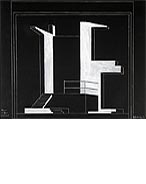 |
 |
The set designs that Gunther
Gerzso did while at the Cleveland Playhouse reflected
his extensive background in art history. Some, such as
his minimalist concepts for Georg Kaiser’s renowned
trilogy, “Gas,” and
for “Macbeth” and “Hamlet,” are
exquisitely illuminated works of art. Gerzso’s
stage sets were a key step in his evolution to producing
Mexico’s
first abstract art. He is considered the artist who
led his nation’s visual art into
modernism.
Click here to
see the artwork. |
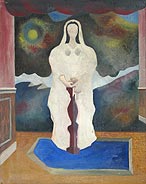 |
 |
In his exploration of various
themes and artistic languages during his esthetic evolution,
one of the movements that attracted the young artist
was Surrealism. Later, when he returned to Mexico City,
Gunther Gerzso began associating with a group of leading
Surrealists, including Leonora Carrington and Remedios
Varo, and during one period Gunther Gerzso was considered a leading
Surrealist by Wolfgang Paalen, founder of the international
Surrealist magazine, DYN.
Click here to
see the artwork. |
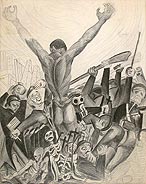 |
 |
| Some of Gunther Gerzso’s
most powerful works during his formative period, when
he was in his early 20s, are his anti-war statements.
Gerzso’s
father was Jewish and his mother German. News of the
Nazis’ pogroms and Kristallnacht, their invasions
of Czechoslovakia, Poland, Denmark, Norway, Holland and
Belgium clearly were deeply disturbing to the young artist.
Click here to
see the artwork. |
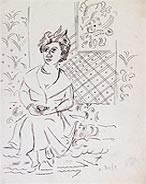 |
 |
Women were one of Gunther
Gerzso’s
favorite subjects, and one of his favorite models during
this period was his new love, a young actress at the
Playhouse named Rilla Gene Cady. Rilla Gene became one
of Gunther Gerzso’s favorite models and posed for most
of his drawings of nudes. In September 1940 they were
wed. Their marriage lasted more than 60 years, until
Gunther Gerzso’s death in 2000.
Click here to
see the artwork. |
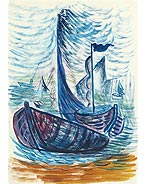 |
 |
| Like all young artists, Gunther
Gerzso tried his hand at drawing imaginative subjects
as well as everyday activities. Items in the news, actors
at the Playhouse, and works by other artists such as
Matisse, George Grosz and the Mexican muralists caught
his eye and were interpreted with his own stylistic touches,
creating a visual diary of the evolution towards
abstract art by a modern
master artist. Click here to
see the artwork. |
|
